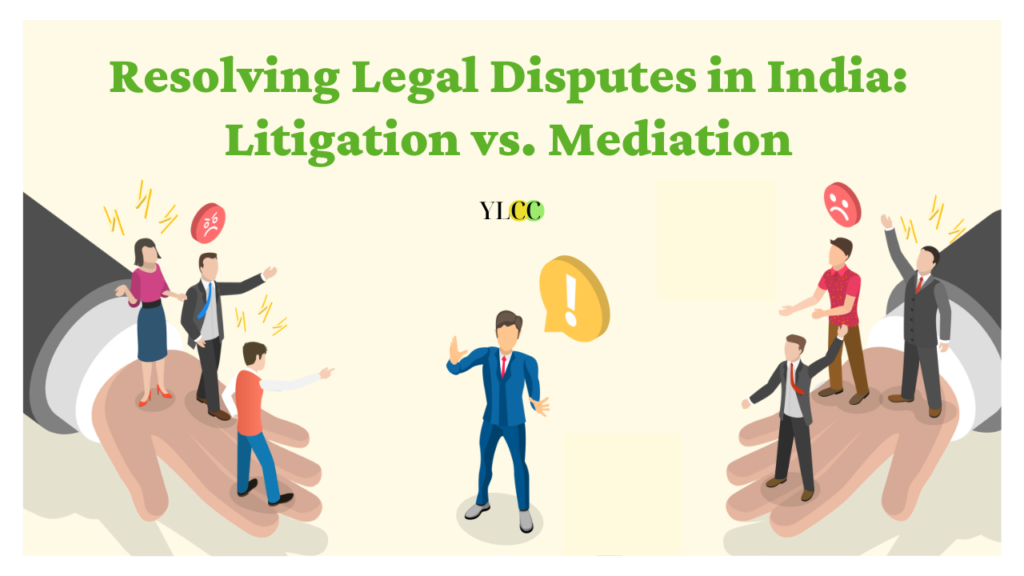
In the mystical realm of the Indian legal system, when conflicts arise, two mighty warriors stand ready for battle: Litigation, the traditional sword-wielding champion, and Mediation, the skilled peacemaker. Let’s embark on a quest to understand these two paths of dispute resolution and discover which one is the true key to justice.
Litigation: The Battle in the Courtroom
- The Sword of Justice: Litigation is the traditional way to resolve disputes, where the aggrieved party wields the sword of justice by filing a lawsuit. The matter is then presented in court, where lawyers duel in the arena of the law.
- The Long and Winding Path: Litigation is a journey filled with obstacles. Legal proceedings can be lengthy, often stretching for years. The battle consumes not only time but also significant financial resources.
- The Verdict: In the end, the judge delivers a verdict. It’s a win-lose situation, where one party emerges victorious, while the other faces defeat. Justice is rendered through legal rulings.
Mediation: The Quest for Compromise
In the land of legal disputes, mediation is like the wise old wizard who seeks harmony and resolution through dialogue and compromise. It’s a journey that takes the parties involved away from the heated battlefield of litigation and into the calm and peaceful negotiation room.
- The Peaceful Negotiator: At the heart of mediation is the mediator, a neutral third party trained in the art of conflict resolution. This mediator is not there to pick a side or make decisions but to guide the parties toward a mutually acceptable agreement. Think of them as Gandalf from “The Lord of the Rings,” offering wisdom and guidance without taking sides.
- The Table of Discussion: Unlike litigation, which unfolds in a courtroom filled with formalities, mediation takes place around a negotiation table. Here, the parties have the opportunity to sit face to face, sharing their perspectives, concerns, and hopes for resolution. It’s a bit like the famous round table of King Arthur, where all voices are heard.
- The Quest for Compromise: In mediation, the goal is not to win or lose but to find common ground. Parties are encouraged to explore potential solutions, brainstorm ideas, and consider compromises. This process can feel like a grand adventure, full of twists and turns as participants navigate toward a peaceful resolution.
- The Treaty of Resolution: Once the parties reach an agreement, it’s not handed down by a judge or imposed by a third party. Instead, it’s a treaty they’ve crafted together, a bit like the alliances formed in epic tales. This agreement is tailored to their unique needs and interests.
Comparing the Warriors:
Cost of Battle:
- Litigation: Legal battles are notorious for their costliness. Lawyers’ fees, court fees, and other expenses can drain your financial coffers.
- Mediation: Mediation tends to be more cost-effective. It often requires fewer sessions and can be completed swiftly.
Time in the Arena:
- Litigation: Legal battles can drag on for years, leaving parties emotionally and financially exhausted.
- Mediation: Mediation is known for its efficiency. Disputes are often resolved in a matter of months or even weeks.
Control Over Outcomes:
- Litigation: Parties have limited control over court proceedings and rely on judges’ decisions.
- Mediation: Parties have greater control and actively participate in crafting the resolution.
Preservation of Relationships:
- Litigation: Legal battles can strain relationships, leaving scars that may never fully heal.
- Mediation: Mediation fosters communication and cooperation, making it more conducive to preserving relationships.
Finality of Resolution:
- Litigation: Litigation results in a binding court judgment that may not fully address parties’ underlying interests.
- Mediation: Mediation produces agreements that reflect parties’ needs and interests, increasing satisfaction and compliance.
Which Path to Choose?
The choice between litigation and mediation depends on the nature of the dispute, your goals, and your willingness to engage in a battle or quest for compromise. Here are some factors to consider:
- Complexity of the Dispute: Complex legal issues may require litigation, while straightforward matters can often be resolved through mediation.
- Cost Considerations: If you’re concerned about costs, mediation might be the more budget-friendly option.
- Relationships: If preserving relationships is crucial, mediation is the preferred path.
- Time Sensitivity: Mediation is generally faster than litigation, making it suitable for time-sensitive disputes.
- Control and Flexibility: Mediation offers more control and flexibility in reaching a resolution.
Conclusion
In the mystical land of Indian legal disputes, both litigation and mediation have their merits. Ultimately, the choice depends on the unique circumstances of your conflict and your quest for justice. So, choose your warrior wisely and embark on the path that leads to the resolution you seek.
YLCC would like to thank Pearl Narang for her contribution to this article.






